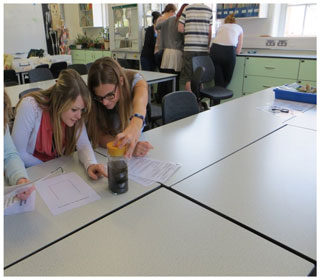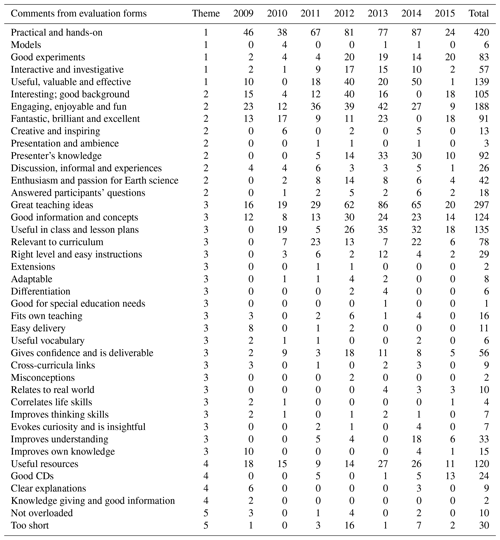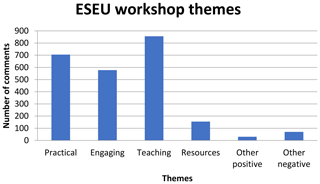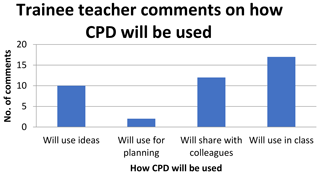the Creative Commons Attribution 4.0 License.
the Creative Commons Attribution 4.0 License.
The value of short Earth science continuing professional development for trainee primary school teachers
Denise Balmer
The paper investigates the potential of Earth science for the development of primary school science. The evaluation from workshops run by the Earth Science Education Unit for trainee primary teachers was appraised to assess the effectiveness of the short continuing professional development (CPD) programmes over the period 2009–2015. Trainee teacher comments are analysed using thematic analysis, which identified points recognised by Guskey (2000) as being the most important ideas for effective CPD programmes. Despite these workshops being short, lasting generally less than 2 h each, the conclusion reached was that they offered useful teaching ideas, resources and background information which the trainees could and would apply in the classroom.
- Article
(1875 KB) - Full-text XML
- BibTeX
- EndNote
The Earth Science Education Unit (ESEU) was founded as a pilot scheme in 1999, and rolled out across the United Kingdom in 2002, to encourage and enhance Earth science teaching by both primary and secondary teachers. The unit was based at Keele University, under the leadership of Chris King, and was initially sponsored for 15 years by UK Oil and Gas (2003–2018). Earth Science continuing professional development (CPD) sessions, which delivered the requirements of the national curriculum and beyond, were presented by a group of trained volunteers, themselves Earth scientists, who offered enthusiastic and accurate information and methodology using low-cost resources. Evaluation of the secondary programme was carried out in 2009 (Lydon and King, 2009). The programmes given to trainee primary teachers over the period 2009–2015 were thoroughly assessed in 2018. The workshops were revised in 2014 to comply with updates in the primary science curriculum.
The current primary curriculum in England contains Earth Science topics scattered within the geography and science curricula. The topics are not well linked within the primary curriculum; for example, knowledge of where volcanoes and earthquakes are located is learnt in geography between ages 7–11 (Key Stage 2) but is not related to forces in the Key Stage 2 science curriculum. Key stage 2 (KS 2) primary science requires knowledge so that rocks to be identified at age 7–8 in addition to knowledge of fossils and some understanding of soil formation. Fossils are looked at again at age 10–11 within evolution, and the basic water cycle is taught in geography and mentioned again in science at age 8–9, where it may be linked with changes in water states, i.e. condensation and evaporation.
The Office for Standards in Education in England (Ofsted; 2013, p. 5) stated that where primary science teachers and science leaders had received subject-specific science CPD sessions, primary science teaching was more effective; in Ofsted's words, the teaching was “more likely to be outstanding”. Australian primary science teachers affirmed that short (up to 4 h long) CPD workshops increased their self-efficacy and had a positive influence on their science teaching (McKinnon and Lamberts, 2014). However, previously, Adey et al. (2004) suggested that the only short CPD courses that would have any real impact on teaching would need to be very specific – perhaps on software applications or assessment methods. The Wellcome Trust report (2013) found that in situations where science subject leaders had received science CPD they could better help any primary teacher in their school who was struggling with science. Shallcross et al. (2002) suggested there was a need for well-integrated science CPD which included background information as well as specific-subject knowledge and pedagogy. Abrahams and Reiss (2012) also felt that there was a need for CPD, especially for practical work, which they thought did not always have clear objectives but was often used to provide a fun lesson. They felt there was a need to make practical work more effective, and their Getting Practical CPD programme was designed to support practical work in science. There has been little published research on the effectiveness of primary science CPD programmes to date. Primary teacher training establishments concentrate more on the pedagogy of teaching science rather than actual information, which, given that most primary trainees (and teachers) are non-scientists, is disappointing (Wellcome Trust, 2013). Discussions with primary teachers in my county during my research revealed disappointment at the lack of actual science knowledge and application available during primary science CPD they had attended (Balmer, 2019).
The primary Earth science workshops I taught were specifically designed to meet the needs of primary teachers with non-science backgrounds. Evaluation of the secondary ESEU workshop data by Lydon and King (2009) showed that this CPD gave teachers both subject content knowledge and pedagogical knowledge, increasing their confidence and effectiveness. Changes to most of these secondary teachers' teaching methods were long term, as shown by a follow-up survey carried out a year after the workshop (Lydon and King, 2009). I analysed the ESEU data collected from the primary trainee teachers' evaluation forms, using thematic coding after the idea proposed by Braun and Clarke (2006). The themes identified were the participants' reactions, their learning and the proposed use of the new skills and knowledge gained from the CPD activities (Guskey, 2000). The themes related well to Guskey's (2000) proposals of evaluating levels of CPD outcomes, which are described later.
The ESEU data were collected during trainee teacher workshops over the period 2009–2015. The workshops were run in a wide range of primary teacher training institutions by their local ESEU-trained facilitator. These various training institutions throughout England had requested a free primary Earth science workshop through Keele University. All workshop facilitators had been trained by the ESEU and completed annual updating training to keep them in touch with new concepts in Earth science and curriculum changes, particularly with the introduction of the new primary science curriculum in 2013–2014.
There were no ethical issues involved. Permission was given by the ESEU to use forms where participants had signed to say they were happy for their comments to be used. All photographs used had the permission of the trainees involved.
The primary trainee teachers participating in the ESEU workshops were from a range of training institutions and programmes across England. The following four different teacher training programmes were available during this period:
-
Teach First – a programme in which participants work in schools and are fully paid whilst on a 2-year training course. The trainees, who have a wide range of backgrounds and experience, are supported by tutors and day release sessions.
-
Post Graduate Certificate in Education (PGCE).
-
Bachelor of Education (B.Ed.) courses.
-
SCITT courses – school-centred initial teacher training programmes.
The trainees' backgrounds and ages varied greatly – some were British nationals and others were from overseas; these data do not show the difference. The workshops comprise a series of low-cost, practical investigations and simulations which can take place in any classroom and are each about 90 min long. In the workshops, the participants were encouraged to work on as many of the investigations or simulations as they could in order to gain as much experience as possible during the time available. The facilitator worked with the trainees, responding to theoretical and practical questions as they arose. The participants were asked to evaluate the workshop sessions after they had taken part in them, and the data and comments from these evaluations, collected by the ESEU, were made available for analysis. The evaluation form requested background information about the trainee teacher's science and Earth science training since taking the General Certificate of Secondary Education (GCSE) and whether the trainee teacher felt confident in teaching Earth science before the workshop input. Given the large sample size, the evaluation forms used were the first 25 % of forms completed for each year, taken from the archive in the order they had been collected at Keele. This is not necessarily the order in which the workshops were taught.
After completing the workshop, each participant was given the resource lists, risk assessments and workshop instructions for the three primary workshops taught so they could use the materials in their schools immediately and pass on the workshop information to their peers. The photograph in Fig. 1 shows trainee teachers investigating soil.
It was not feasible to examine all the evaluation forms for the extent of the programme (some 5000+ forms). A simple, random sample of 25 % of the forms for each year the workshop programme was taught, from 2009 to 2015, (1395 forms) was analysed. The forms analysed were from teacher training establishments across England. The ESEU data are partly in Likert scale form, but the part of the evaluation of most interest to me was the comments section that was written immediately after the workshop. The ESEU evaluation form requested data in several formats, as follows:
-
Background information on trainee teachers.
-
A total of 11 questions to be answered, on a Likert scale, referring to amount of Earth science that trainees may be teaching (most of these data were not used in this study).
-
Participants' comments about their workshop experience (these data have been used for the purpose of this study).
When analysing these data, I transcribed all the comments on the sampled evaluation sheets to determine themes and in order to be able to analyse them using thematic analysis (Braun and Clarke, 2006). The comments were linked to form themes, which are described later.
The background information data were extracted from the evaluation forms and tabulated so that different years could be compared, as seen in Table 1.
From Table 1, it can be seen that the number of female trainees participating in the workshops is much greater than the number of male participants, who are around one-fifth of the overall total (22 %), in line with government statistics for 2015 which show that 85 % of primary teachers are female (Department for Education, DfE, 2015, p. 7).
Table 1Compilation background data of primary trainee teachers taken from the data on the ESEU evaluation forms collected during 2009–2015.

The number of trainees who stated they had learnt any Earth science or geology during GCSE was 59 %. A small amount of Earth science was included in GCSE physics/chemistry up to 2014, but the respondents may not have appreciated Earth science as a specific topic within the curriculum. The workshops evaluated mostly took place before the 2014 changes in the national curriculum, which have now virtually removed Earth science from the secondary science curriculum and placed it in geography, with a more social emphasis, which means that the next generation of teacher trainee recruits will probably have studied even less Earth science, from a science perspective, up to the age of 16. There is, however, more Earth science in the primary curriculum from 2014. About 10 % of trainees said they had studied Earth science or geology after their GCSEs, with some stating that it was a minor part of a degree course (approximately 10 %), while others had studied Earth science as a larger part of their degree (2.8 %). But, overall, few primary trainee teachers in my sample have science degrees (Table 2), although it is not necessarily the case that those who do are able to teach science better than their colleagues as they sometimes cannot relate their science studies to the level required in primary school (PSST, 2016).
Further data from the evaluation form are shown in Table 3, which shows the percentage of trainees' confidence in teaching primary science. (Note: some teachers were confident in more than one subject.)
The data in Table 3 show that, between 2009 and 2015, 65 % of the participants stated they were confident in teaching primary biology, but confidence in teaching chemistry, physics, Earth science and geology (the other sciences in the primary science curriculum) was much lower at 14 %, 16 %, 4.6 % and 0.85 %, respectively. These data are shown in Fig. 2.
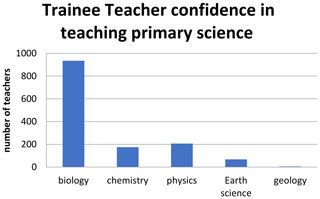
Figure 2Bar graph showing overall trainee teacher confidence in teaching primary science from 2009–2015.
In 2015, however, confidence in teaching biology within the sample had fallen from a high in the previous year to its lowest level, while the same year, 2015, showed an increase in confidence in teaching chemistry and physics. This difference between chemistry and physics, on the one hand, and biology, on the other, may relate to the 2014 changes to the primary curriculum, which reduced the amount of chemistry and physics in the curriculum. Overall, though, a much higher percentage of teachers had no confidence in teaching primary science in 2015 (25 %), which is a huge increase compared to previous years, as seen in Fig. 3. If teachers are not confident in their ability to teach a subject, this can often affect their enthusiasm and ability to enthuse their pupils (Aalderen-Smeets and van der Molden, 2013). Across the 2009–2015 period, only 1.1 % of the trainees stated that they were confident in teaching all of primary science.
Confidence in teaching geology and Earth science was low (averaging 5.7 % across the 2009–2015 period) before the workshop, as stated by the trainees on the evaluation form (Fig. 3).
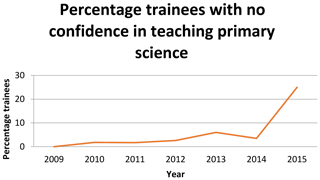
Figure 3Percentage of teacher trainee participants at ESEU workshops stating they had no confidence in teaching primary science prior to participating in the workshop.
One worrying feature is that the graph suggests an increasing percentage of primary trainees who state that they have no confidence in teaching primary science (Fig. 3). Since the major increase occurs after the implementation of the new national curriculum, it may be that trainees feel less confident with the new programmes and their assessment procedures.
A Likert scale was used in the CPD evaluation form to ascertain whether the respondents felt that the workshop had increased their confidence. All participants (n=1395) indicated that their confidence had increased, and many of the comments used in the later analysis stated that their knowledge and understanding had improved.
The trainees were asked to comment on their workshop experience on the evaluation form. There were 2365 comments from the 1395 participants; these were transcribed and classified into six themes in the following manner, as described by Braun and Clarke (2006). A list was made of all the comments, and these were initially grouped under headings (Table 4) which were then categorised to form themes. These themes were identified as the main benefits the trainees had identified from the workshop.
In the following, the themes are described below, and the information shown in Table 4 is mentioned.
-
Theme 1 (practical) – 705 comments relating to the effectiveness of the practical activities and investigations, and the usefulness of the CPD in the classroom. For example, “very hands-on workshop providing valuable information” and “effective interactive investigations shown”.
-
Theme 2 (engaging) – 578 participants' comments about how workshops would be received by primary children and learning points which could be made. Example comments include, “inspiring activities” and “relevant local issues could be used”.
-
Theme 3 (teaching) – 856 comments about the ease of delivery, use of good vocabulary, differentiation in use, level of approach and the clarity of the explanations, i.e. “simple explanations of correct vocabulary” and a “range of practical work to suit all levels”.
-
Theme 4 (resources) – 155 comments relating to the simplicity, availability and inexpensive use of everyday items for the investigations and simulations. Comments included those such as “no need for laboratory equipment” and “use of empty plastic bottles and yoghurt cups a good idea”.
-
Theme 5 – 30 positive comments, including ones on the length and timing of the CPD workshop and how the participants felt about teaching Earth science after the workshops. Points made included comments like “no overload of ideas” and “just right length of CPD”.
-
Theme 6 – 41 negative comments, including those from participants who did not intend to use the exercises in their classes. One comment suggested that the workshop was too slow and too long.
In the practical theme, the trainees' comments stated that the workshop sessions provided “effective simulations and hands-on practical investigations” that were both interactive and investigative. Trainees felt that these investigations would appeal to the children's imaginations and that pupils would identify with the concepts from the investigations, thus dispelling alternative conceptions, evoking curiosity and improving thinking skills and knowledge and understanding. This can be seen as effective pedagogy, which enables learning. The workshops gave ideas for making a simple water cycle model, for using practical activities to show how soil erosion could be curtailed by vegetation and for using a piece of guttering to replicate a river's flow, simulating relevant experiences that children may experience in their local area.
The engaging theme brought together the trainees' comments about their feelings of working on the Earth science investigations, and how they thought these investigations and simulations would run in their primary classroom. They also commented that “the investigations would provoke discussions and the asking of many questions”, again invoking effective learning pedagogy as the children would recall the practical side of the investigations and working together.
The teaching theme included points about the use of appropriate and relevant vocabulary, the ease of delivery and the fact that the experiments could be differentiated for differing abilities. Using scientific language in an appropriate setting was an important point made; children could visibly see evaporation and condensation in the water cycle simulation, and permeability could be measured in the rock and soil investigations. Trainees stated that “they could use the workshop materials in their own teaching and use them for cross-curricular purposes as well”.
The resources theme recognised that these investigations could be carried out using simple equipment made from everyday items, for example, lemonade bottles and coffee filters. Trainees also acknowledged the usefulness of the CDs which contained all the necessary investigative ideas and risk assessments.
Some of the positive points raised were the clear explanations given by facilitators, and the fact that the materials could easily be differentiated for different abilities and also used for teaching pupils with special educational needs. The subject knowledge input was appreciated, as was the discussion which arose during the workshop, as all the facilitators would endeavour to explain the scientific concepts behind some of the practical investigations and simulations. Negative points that were made by trainees were on the length of the CPD (“too short”) and regarded “the need for more Key Stage (KS) 1 and Early Years Foundation Stage (EYFS) resources”, despite the CPD being advertised for KS 2 trainees.
Overall, the feedback was positive, with few negative comments. The comments received from the trainees about the ESEU workshop were very encouraging and show what a well-designed short CPD session can achieve. Trainee teacher comments on how they will use their newly gained knowledge are shown in Fig. 5.
CPD of this nature can greatly enhance a trainee's pedagogical content knowledge by providing ideas on how to teach concepts, increasing the trainees' self-efficacy and, hence, the likelihood that they would use the material in their teaching. Various anecdotal comments from participants after a workshop have been along the lines of, “Oh good, I have to teach soils and rocks in my next teaching practice, so now I know what to do”, and “I wish we had had this workshop before my last teaching practice as I had to teach about rocks and soils and really did not understand it, but I do now”.
The workshops offer opportunities for discussion and questioning and for pupils to develop the investigative ideas offered in different ways in order to answer their own queries. For example, using the investigation simulating coastal erosion, pupils can change the wave direction and strength, the size of material being moved by the waves and the cliff material composition (more clayey, sandy or gravelly). These different simulations can be linked to real-life examples happening around the British coastline, making them very relevant to where the children live or go for their holidays. Learning becomes more accessible (Balmer, 2019) and connected through pupils noticing the changes in a practical manner, and children can explain the erosion concepts from their observed understanding. Children give verbal feedback from their visual experiences, and playing with sand and water has a “wow” effect which may well be remembered. All the investigations offered in the ESEU CPDs enable a range of concepts to be examined and taught, which, when investigated at a simple level that is applicable to the age of the participants, provides a motivating and, therefore, hopefully lasting impression.
Trainees commented that providing concrete experiences using local resources would benefit their teaching, as suggested by Fitzgerald (2012). The workshops continually promoted the use of local soils, rocks and fossils and examples relating to the “real world”. The simulations offered models to help understand concepts such as the water cycle, which is a difficult idea for children to grasp. The CPD provides effective teaching and learning and opportunities to assess the children's progress through their oral or written understanding.
The trainees identified ways that they would use their CPD session when at school. A number believed they would be able to use the material directly, during teaching practice. Some also stated that they would have liked to have had the resources and ideas earlier so they could have used them during their teaching practice. Other trainees felt they could modify the ideas to fit their teaching programmes, while some said they would share these ideas and use them for planning future work.
The themes categorised by the trainee teachers relate closely to those identified by Guskey (2000) as being important outcomes for an effective CPD. Guskey suggested that the CPD can be evaluated at the following five levels of outcomes:
-
Level one – participant reactions.
-
Level two – participant learning.
-
Level three – organisational support and change.
-
Level four – participants' use of new knowledge and skills.
-
Level five – student learning outcomes.
Levels one, two and four are applicable here.
Level one, participant reactions, can be identified through all the positive and negative statements made by the participants after the CPD (Table 4). Of the 49 different points identified, only four are negative, showing that the statements made over the 2009–2015 period indicate positive reactions.
Level two, participant learning, is indicated within the themes in a number of places and not just under “knowledge giving”. For example, comments such as “good information given”, “answered participants' questions”, and “discussion and informal experiences” all suggest learning.
Level four, participants' use of new knowledge and skills, has been graphed in Fig. 5 and identifies how the participants say they will use the CPD information.
Since these were only trainee teachers participating in the CPD, they had no way of influencing their organisations (level three) or of knowing the student outcomes (level five) at the time.
At the end of the workshop, each primary trainee was given a USB stick, which held a complete set of the materials and instructions used in the workshop, linked to references in KS2 primary science curriculum. This gave rise to the following comments: the instructions had “clear explanations”, the activities were “instantly available to use in the classroom because of the ease of obtaining resources”, and they gave “good knowledge in a format useful for children and trainees”.
The results from the analysis of the comments show that participants' feelings towards the workshops were overwhelmingly positive, with very few negative comments (1.7 %). The CPD provided subject content knowledge (SCK) and pedagogical content knowledge (PCK) for teaching Earth science for trainees with little or no science background, enabling them to use scientific ideas confidently. Trainees stated that the provision of resource materials, such as the CPD which contained all the investigations and risk assessments, would be very useful when teaching this section of the primary science curriculum. Informal discussions revealed that trainees were thinking further than the given ideas, and in fact using the CPD as a starting point for other topics in the primary curriculum; for example, the simulations of coastal erosion, river processes and the water cycle can be linked to geography, history, biology, design and technology. This makes the time spent on one CPD time well used.
The main themes identified by the participants – practical, engaging, teaching and resources – all relate to sound pedagogical practices as identified in the 10 Teaching and Learning Research Programme (TLRP) principles of effective pedagogy (James and Pollard, 2011). The theme “practical” embraces interactive, investigative practices, which are valuable and effective. The trainee teachers were motivated and stated under the engaging theme that there was scope for questioning and discussion, leading to higher order thinking and critical thinking. The “teaching” theme entailed identifying misconceptions, using appropriate vocabulary and adapting and differentiating activities to evoke curiosity and insight and make the activities suitable for planning and later assessment.
As already suggested, the workshop reflects with those points identified by Guskey (2000) as being effective CPD outcome levels. The CPD is therefore seen to be an effective teaching strategy in its design and delivery by its participants, meaning that, when using Guskey's (2000) criteria, an applicable short workshop is being provided.
A further piece of research which looked at the impact of focused CPD on teachers' subject and pedagogical knowledge was undertaken by Scott et al. (2010). These researchers stated that, where CPD was domain-specific and teachers were able to focus on learning, teachers found the CPD effective and useful. Many respondents in this survey said that they would use the pedagogical ideas in their teaching, and that the CPD had provided additional subject content knowledge they could use. Scott et al. (2010) looked specifically at secondary physics and chemistry short CPD provision because of the shortage of secondary physical science teachers. King and Thomas (2012) evaluated short Earth science CPD intervention workshops for secondary teachers with similar conclusions. My research suggests that these primary Earth science CPD workshops were as effective as these secondary workshops in providing both pedagogical and subject content knowledge.
The ESEU primary teacher trainee evaluation forms had not previously been investigated, although analysis of the CPD impact on secondary science teachers and science trainee teachers had been undertaken (Lydon and King, 2009). That analysis of the secondary CPD showed that even though some of the research literature concludes that short-term CPD is not effective, the ESEU CPD led to increases in knowledge and understanding, at least as stated by the participants. Furthermore, a follow-up postal survey of participating secondary teachers carried out 1 year after the CPD indicated that teacher practices had changed, indicating long-term benefits from these short CPD workshops (Lydon and King, 2009).
The findings from the primary evaluation forms indicate that the workshops given to primary teacher trainees were well received. Comments suggest that the trainee teachers intended to use Earth science in their primary science work because they saw it as being relevant to their pupils' everyday lives. King and Thomas (2012) calculated the impact secondary ESEU short CPD workshops had on the number of trainee teachers, teachers and, using a multiplier gauge, number of students. My research shows how the primary education sector benefitted too as some 700 primary teachers, who attended workshops between 2008–2011 (ESEU data), could influence some 18 000 primary pupils annually. The total number of trainee teachers who had attended the workshops between 2009 and 2015 was 5580 (ESEU data). The majority of these trainees would be teaching pupils in the coming years, adding to the number benefitting from the CPD.
The trainee primary teachers said that the materials fitted in well with their approach to teaching and were relevant to the curriculum. Harlen and Elstgeest (1992) stated that it is important that teachers have their own understanding of a subject before they teach it or explain it to their colleagues. These workshops provide that understanding at an appropriate level for primary science. Unfortunately, it was not possible to follow up with a postal survey of the trainees' teaching practices, as was done for the secondary workshops, since the trainees completed the activities while not in permanent employment in schools, meaning that the time that has elapsed since the training took place is too great, and contact details are not available.
Overall, the evaluation from these workshops suggests that the trainee teachers will use the materials to the benefit of their primary pupils with confidence. This evaluation shows that the workshops are fulfilling a need by offering relevant subject and pedagogical knowledge, and that they do increase confidence in teaching primary science. The trainees were devising their own plans for implementing these investigations, which will surely enrich their teaching, not just in Earth science but also by relating the concepts they had learnt to the overall science curriculum.
It is interesting that in the data the only science subject that many of the primary teacher trainees felt confident about teaching, before participating in the CPD workshops, was biology. Perhaps biology is as close as primary and secondary school science comes to looking at science which is relevant to young people? Everyone has some understanding of their own biology, but we rarely develop the science that is around us all the time. The physics strand of the primary science curriculum is often seen as difficult by trainee teachers, who feel less confident when having to teach it (McCrory and Worthington, 2018). Earth science can be used to introduce physics concepts such as forces, using children's relevant experiences of wind and its effects. King (2012) suggested that Earth science should not only form a significant part of primary children's science curriculum but for all children up to age 16. Although the present primary science curriculum has included more Earth science, the linkages are unclear and, as with the rest of this curriculum, topics are isolated where they could be so easily integrated. Why are we not making greater use of everyday Earth science materials and events in our primary science teaching as these are available resources of which we all have experience?
Every child needs to understand their own surroundings and how soils, rocks, weather plants and habitats work together. Surely a better understanding of our own Earth science would encourage an appreciation of the importance of local changes on a global scale. Now is the time to ensure that the next generation have this knowledge and understanding.
Data are logged in UK Data Archive at the University of Essex (https://ukdataservice.ac.uk/, last access: October 2020) reshare@ukdataservice.ac.uk; Record 854373: An evaluation of short Earth science CPD for trainee primary teachers.
The author declares that there is no conflict of interest.
My thanks are due to Chris King for allowing me to use data collected by my Earth science facilitator colleagues and to “Steve” for making them accessible.
This paper was edited by Katharine Welsh and reviewed by two anonymous referees.
Aalderen-Smeets, S. and van der Molden, W.: Measuring primary science teachers' attitudes toward teaching science, Int. J. Sci. Educ., 35, 577–600, 2013.
Abrahams, I. and Reiss, M. J.: Practical work: its effectiveness in primary and secondary schools in England, J. Res. Sci. Teach., 49, 1035–1055, 2012.
Adey, P., Hewitt, G., Hewitt, J., and Landau, N. The professional development of teachers: practice and theory, in: Professional development for cognitive acceleration: intuition, Kluwer Academic Publishers, London, Chapter 4, 17–30, ISBN 978-1-4020-2005-6, 2004.
Balmer, D.: The potential of earth science for the development of primary school science, PhD thesis, UCL, London, UK, 2019.
Braun, V. and Clarke, V.: Using thematic analysis in psychology, Quality Research in Psychology, 3, 77–101, 2006.
Department for Education (DfE): Statistics on the size and characteristics of the schools' workforce in state-funded schools, In: Statistics: school workforce, GOV.UK, p. 7, available at: https://www.gov.uk/government/collections/statistics-school-workforce (last access: 15 January 2021), 2015.
Fitzgerald, A.: Providing Students with Concrete Experiences of Science, Chap. 5, in: Science in primary schools: Examining the practices of effective primary school teachers, Sense Publishers, The Netherlands, 53–65, ISBN 9789460918568, 2012.
Guskey, T. R.: Evaluating professional development, Thousand Oaks, California, ISBN 9780761975601, 2000.
Harlen, W. and Elstgeest, J.: The UNESCO sourcebook for science in the primary school: a workshop approach to teacher education, UNESCO, Paris, UNESCO Source Book, ISBN 9789231027215, 1992.
James, M. and Pollard, A.: TLRPs ten principles for effective pedagogy: Rationale, development, evidence, argument and impact, Res. Pap. Educ., 26, 275–328, 2011.
King, C.: Earth science: Editorial, School Science Review, 94, 23–24, 2012.
King, C. and Thomas, A.: Earth Science Education Unit workshops: evaluating their impact, School Science Review, 94, 25–35, 2012.
Lydon, S. and King, C. J. H.: Can a single, short continuing professional development workshop cause change in the classroom?, Professional Development in Education, 35, 63–82, 2009.
McCrory, A. and Worthington, K.: Mastering primary science, Bloomsbury, London, ISBN 9781474277457, 2018.
McKinnon M. and Lamberts, R.: Influencing science teaching self-efficacy beliefs of primary teachers: a longitudinal case study, Int. J. Sci. Educ., 4, 172–194, 2014.
Ofsted (Office of Standards in Education): Maintaining curiosity in science, Stationery Office, London, ISBN 9781528616928, 2013.
PSST (Primary School Teaching Trust): http://www.psst.org.uk/ (last access: 15 January 2021), 2016.
Scott, P., Ametller, J., and Edwards, A.: Impact of focused CPD on teachers' subject and pedagogical knowledge and student learning, Centre for studies in science and mathematics education, Leeds, UK, Chap. 7, discussion p. 102, 2010.
Shallcross, T., Stephenson, E., Warwick, P., and Warwick, P.: How primary trainee teachers perceive the development of their own scientific knowledge links between confidence, content and competence, Int. J. Sci. Educ., 24, 1293–1312, 2002.
UK Data Archive, University of Essex: https://ukdataservice.ac.uk/, last access: October 2020.
Wellcome Trust: The deployment of science and maths leaders in primary schools, study, Wellcome Trust, London, available at: https://cms.wellcome.org/sites/default/files/wtp056231_1.pdf (last access: 1 February 2021), 2013.
- Abstract
- Introduction
- Method of ESEU data collection from CPD primary workshops held in England, 2009–2015
- Results of the ESEU data collection – the data
- Trainee comments written on the ESEU evaluation forms
- Identifiable pedagogy within the ESEU workshops
- Discussion of the ESEU CPD results
- Potential of Earth science for the development of primary science
- Data availability
- Competing interests
- Acknowledgements
- Review statement
- References
- Abstract
- Introduction
- Method of ESEU data collection from CPD primary workshops held in England, 2009–2015
- Results of the ESEU data collection – the data
- Trainee comments written on the ESEU evaluation forms
- Identifiable pedagogy within the ESEU workshops
- Discussion of the ESEU CPD results
- Potential of Earth science for the development of primary science
- Data availability
- Competing interests
- Acknowledgements
- Review statement
- References






